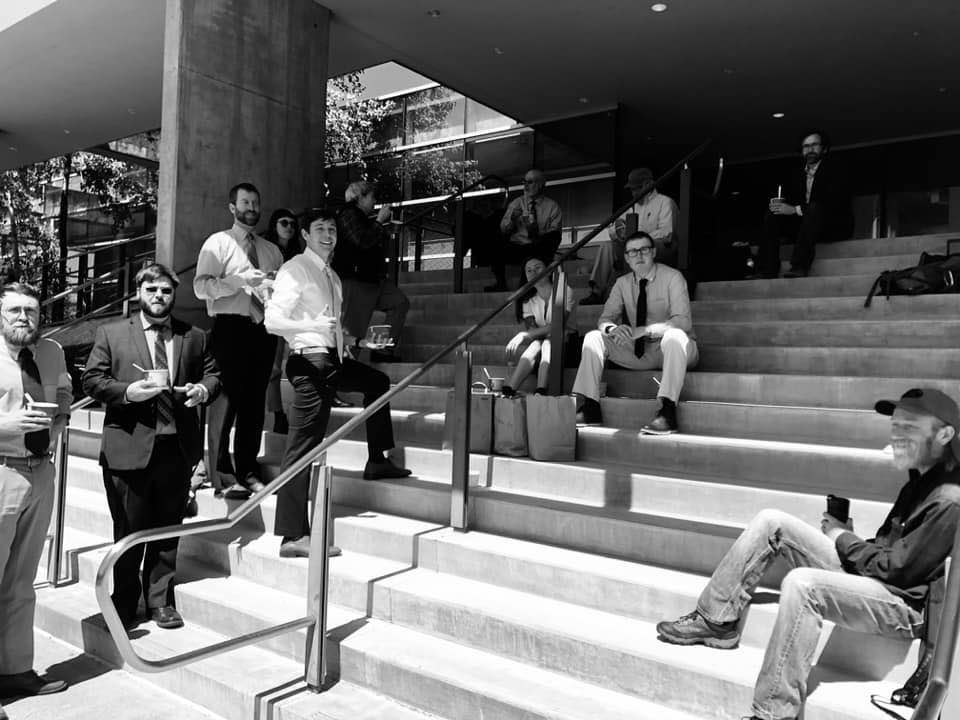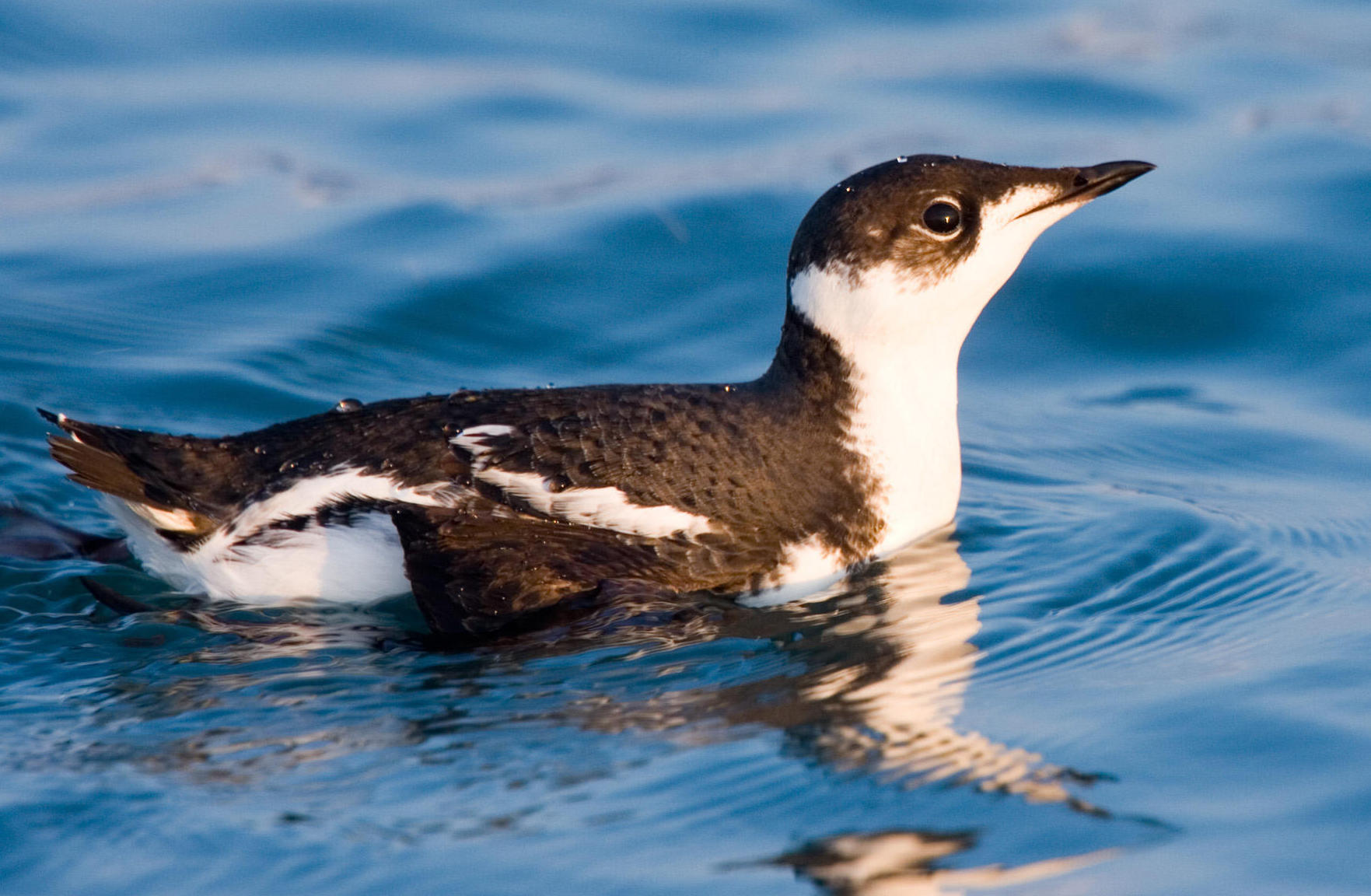By Gabriel Scott, Cascadia Wildlands Staff Attorney

Cascadia team outside the courthouse day 1 of the trial
It may not be the trial of the century, but Monday saw the start of the trial of a lifetime for some cryptic, secretive seabirds nesting in the Elliot State Forest. The case is Cascadia Wildlands v. Scott Timber Company, and it is taking place this week in judge Aiken’s Courtroom #1 at Federal District Court in Eugene. At issue are the timber company’s plans to clearcut log 46 acres of old-growth forest from the Benson Ridge parcel of what used to be the Elliott State Forest, in the Oregon coast range not far from the town of Lakeside. Stopping the saws are the unobtrusive seabird, the Marbled Murrelet, which nests in old-growth forest; and a persistent group of forest defenders who care about them.
Usually, environmental destruction never makes it into a court of law. There are almost no laws protecting our environment; only laws protecting people. One rare exception is the endangered species act, a law which makes it illegal to drive a species to extinction. Because the Murrelet is listed as Threatened under the Endangered Species Act, and because citizen surveyors actually found nesting Murrelets in this specific stand of trees, Cascadia was able to sue to stop the logging on the logic that it would result in illegal “take” of Murrelets.
The atmosphere is nervous as the assembled crowd waits for the judge to make her entrance. Dark-suited attorneys sit at the tables on either side of the room, computer monitors in front of them showing a photograph of a Marbled Murrelet on the sea. Gathered in the room are attorneys, citizen advocates, and bird scientists. The bird on the monitor is the real plaintiff in the case. The obligation to speak for the bird that can’t speak for itself weighs heavy.
Lead counsel for the good guys is Cascadia’s own Dan Kruse, an accomplished environmental and criminal defense attorney who judge Hogan once called a tall glass of water. We also know him as a cut-throat Poker champion, and steadfast forest defender.
In opening statements, the contest begins to take shape. The Marbled Murrelet, a rare seabird, nests exclusively on branches of big trees in the coast range. Loss of that old forest to logging is the main reason they are going extinct. Scott Timber, which recently bought some acreage of old-growth from out of the Elliott State Forest, wants to clearcut log one of those stands of old-growth. In 2014, citizen surveyors with Coast Range Forest Watch found and documented Murrelets nesting in that very stand.

Marbeled Murrelet (photo by the Audubon Society).
The law says you can’t knowingly harm a threatened species. Our case is that logging this old-growth, by destroying nest trees and making neighboring trees more vulnerable to predators, would harm Marbled Murrelets. We aren’t demanding money; just that they stop the logging.
The logging company’s opening statement sets out their view. They say we have a high burden of proving that this tract is essential to particular Marbled Murrelets, and that logging it would cause some specific problem for some specific bird. This is a familiar line of argument from earth-destroyers. They love to complain about uncertainty until it is too late.
Plaintiffs first burden is to show “standing.” This is an odd legal doctrine that requires someone bringing a lawsuit to show that they will be personally harmed by the lawbreaking. The law doesn’t protect nature. It only protects humans. It is not enough to show that Scott Timber would illegally kill Murrelets. We also have to prove that in killing those Murrelets, it will hurt us.
Filling that task for us is Francis Eatherington, a long-time forest activist. On the stand she testifies to how many times she has been in this particular stand of trees, how she has enjoyed it, and how she would be hurt by a clearcut. Francis is a perfect witness, personable and relatable. Her sharp knowledge of the facts on the ground, understanding of the law, and long experience give her undeniable credibility.
The logging company half-heartedly tries to catch her in a trap. Isn’t it true, they ask, that what she really cares about is the forest? That she is only pretending to care about Murrelets because they can stop this logging?
Francis’ eyes light up as she takes the opportunity to explain holistic worldviews to the young timber industry lawyer. Yes, it is about the forest, she explains, and what forest includes Murrelets It includes the trees, the plants, the wildlife and birds, including the Marbled Murrelet.
Next on the stand is Max Beeken. Clean-cut in a slacks and tie, Max does not look the stereotype of a forest defender. The Port Orford resident with a bachelor of science in field biology is a co-founder of Coast Range Forest Watch, an all-volunteer group that does citizen science to protect the coast range forests.
Marbled Murrelet surveys are a big part of what they do. Part of Max’s job is keeping track of all of the Murrelet survey forms from volunteers, so the attorney walks him through page after page of Murrelet surveys. The group has done about four hundred surveys looking for Murrelets.
Our attorney pauses on the survey form that showed Marbled Murrelets nesting in this stand. One survey, on May 24, 2014, is what this case comes down to.
The attorney pauses also on several surveys that did not find Murrelets, including one by Max himself where a Murrelet was detected, but not at the elevation that would show it was nesting. Why not just fudge the numbers a little bit, the attorney asks?
He answers simply: because that wouldn’t be true.
Industry tries to “impeach” Max only half-heartedly. Isn’t it true that he was affiliated with Cascadia Forest Defenders? Well yeah, and…?
Next on the stand is Clark McMahon, also a co-founder of Coast Range Forest Watch and a professional tree climber and surveyor. Clark spends a lot of his time doing surveys for timber companies, so it’s hard to challenge his credibility. That doesn’t stop the industry attorney from trying.
Isn’t it true he was arrested for criminal trespass a decade ago at a protest on the Elliott State Forest? Isn’t it true he was affiliated with Cascadia Forest Defenders? Yes and yes and…
But the industry lawyer’s gambit doesn’t work. McMahon, like Beeken and Eatherington, is not even remotely ashamed of protest activities. The line of accusation only bolsters their integrity. The judge gives a look. The industry attorney sits down.
The day’s highlight came with Clark on the stand. After having described in agonizing detail the survey protocol for Marbled Murrelet nesting, we hear audio recordings of his field notes. The courtroom is suddenly full of the silence of the forest at dawn. Clark’s voice, softly speaking into his recorder, notes the time, 5:30 a.m., weather a calm 58 degrees, and his observations. Two thrushes. A Robbin. At 5:30 he records seeing a Murrelet only 15 meters away, flying a straight line, but above the canopy.
Then comes the magic moment: two birds at zero-point-eight canopy, flying west, seventy meters away.
I am full of pride in Cascadia and gratitude for these citizen surveyors. They are actually pulling this off. They are giving the bird— one of our relations in Cascadia who can’t speak for itself— a voice in the courtroom.
Stay tuned…
